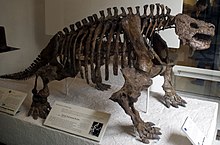Hallucicrania
| Hallucicranians Temporal range:
| |
|---|---|

| |
| Skull of Lanthanosuchus watsoni, a lanthanosuchoidean | |

| |
| Skeleton of Scutosaurus karpinskii, a procolophonian | |
| Scientific classification | |
| Domain: | Eukaryota |
| Kingdom: | Animalia |
| Phylum: | Chordata |
| Class: | Reptilia |
| Clade: | †Parareptilia |
| Order: | †Procolophonomorpha |
| Clade: | †Hallucicrania Lee, 1995 |
| Subgroups | |
| Synonyms | |
| |
Hallucicrania is an extinct clade of procolophonomorph parareptiles from the early Cisuralian epoch (middle Sakmarian stage) to the latest Triassic period (latest Rhaetian stage) of Africa, Antarctica, Asia, Australia, Europe, North America and South America.[1][2]
Phylogeny
Hallucicrania was named Michael S. Y. Lee in 1995, and defined as the node-based taxon formed by Lanthanosuchoidea and Pareiasauria and all its descendants.[3] The clade Ankyramorpha named by the paleontologists Michael deBraga and Robert R. Reisz in 1996 was given nearly the same definition - "the most recent common ancestor of Procolophonia and Lanthanosuchoidea and all its descendants".[4] Under all current phylogenetic analyses, both clades contain the same species, and thus Ankyramorpha should be considered a junior synonym of Hallucicrania - a fact ignored in most of the recent publications, which keep applying Ankyramorpha for this clade.[5][6]
The following cladogram is simplified after the phylogenetic analysis of MacDougall and Reisz (2014) and shows the placement of Hallucicrania (their Ankyramorpha) within Parareptilia. Relationships within emboldened terminal clades are not shown.[6]
| Parareptilia |
| ||||||||||||||||||
References
- ^ Marcello Ruta; Juan C. Cisneros; Torsten Liebrect; Linda A. Tsuji; Johannes Muller (2011). "Amniotes through major biological crises: faunal turnover among Parareptiles and the end-Permian mass extinction". Palaeontology. 54 (5): 1117–1137. doi:10.1111/j.1475-4983.2011.01051.x.
- ^ Jalil, N. E., & Janvier, P. (2005). Les pareiasaures (Amniota, Parareptilia) du Permien supérieur du Bassin d’Argana, Maroc. Geodiversitas, 27(1), 35-132.
- ^ Michael S. Y. Lee (1995). "Historical Burden In Systematics And The Interrelationships Of 'Parareptiles'". Biological Reviews. 70 (3): 459–547. doi:10.1111/j.1469-185X.1995.tb01197.x.
- ^ Michael deBraga; Robert R. Reisz (1996). "The Early Permian Reptile Acleistorhinus pteroticus and Its Phylogenetic Position". Journal of Vertebrate Paleontology. 16 (3): 384–395. doi:10.1080/02724634.1996.10011328. JSTOR 4523731.
- ^ Linda A. Tsuji; Johannes Müller; Robert R. Reisz (2012). "Anatomy of Emeroleter levis and the Phylogeny of the Nycteroleter Parareptiles". Journal of Vertebrate Paleontology. 32 (1): 45–67. doi:10.1080/02724634.2012.626004.
- ^ a b Mark J. MacDougall; Robert R. Reisz (2014). "The first record of a nyctiphruretid parareptile from the Early Permian of North America, with a discussion of parareptilian temporal fenestration". Zoological Journal of the Linnean Society. 172 (3): 616–630. doi:10.1111/zoj.12180.


